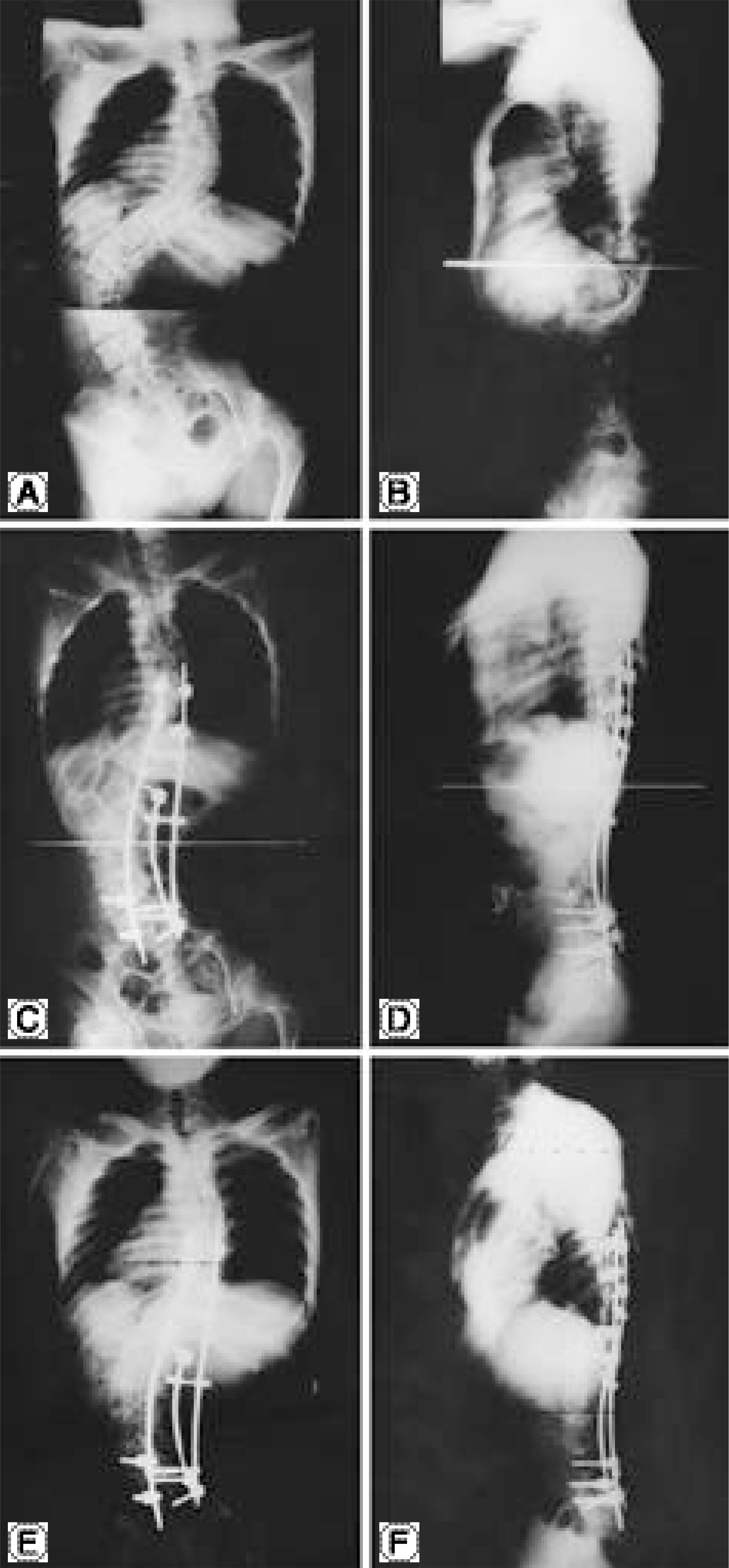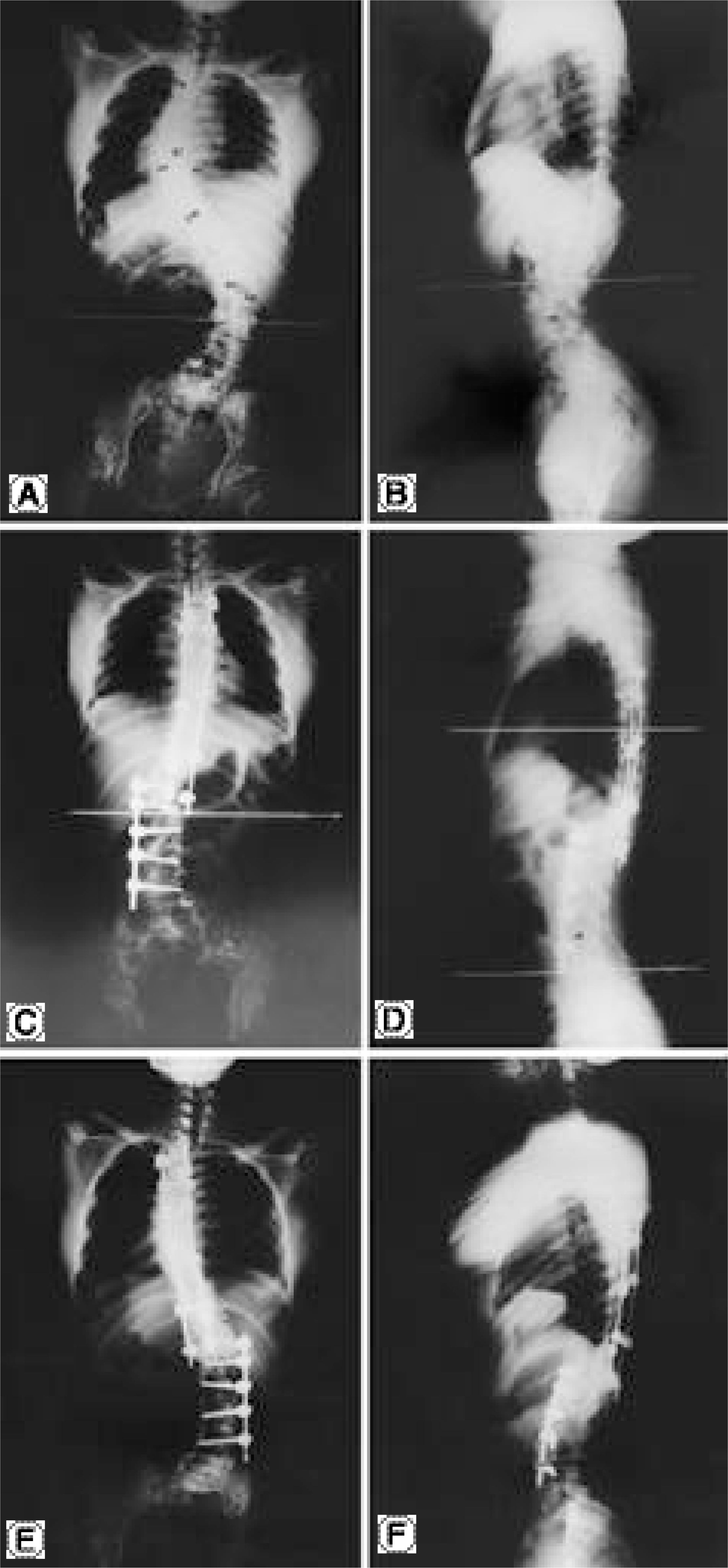Abstract
Study Design
A retrospective study of functional outcome after surgical correction of neuromuscular scoliosis.
Objectives
To assess functional outcomes and their significances after the surgical correction of neuromuscular scoliosis.
Summary of Literature Review
The surgical correction of neuromuscular scoliosis has been used to stabilize the trunk for balanced sitting, to improve cardiopulmonary function, and the function of the upper extremities. Many authors have reported favorable surgical results, but few studies have been undertaken on functional assessment after surgery.
Materials and Methods
Eighteen adult patients with neuromuscular scoliosis underwent surgical correction. Functional assess-ments were performed in terms of impairments, disabilities, and handicaps. The impairments included sitting ability, coronal Cobb's angle, pain after surgery, and cosmesis after surgery. The disabilities included dressing, feeding, toilet/bathing, locomotion, and the use of both hands, and the handicaps included the effort and time to care for patients. Each parameter was checked preoperatively, 6 months after surgery, and at the last follow- up.
Results
In terms of impairments, sitting ability, coronal Cobb's angle, pain, and cosmesis were improved by surgery. In terms of disabilities, dressing, toilet/bathing, and locomotion were not improved after surgical correction. However, the feeding and use of both hands were significantly improved. A nd, in terms of handicaps, both the effort and the time required for care were reduced post- surgically.
Conclusions
We conclude that impairments, handicaps, and the functions of the upper extremities were improved after surgical intervention to stabilize the trunk and spine in cases of neuromuscular scoliosis, but that overall disabilities were unaffected. This latter apparent shortcoming is attributed to the inability of surgery to treat previous systemic disease affecting physical disabilities of lower extremities. However, surgical correction of neuromuscular scoliosis was found to be clinically significant in terms of improving the functions of the trunk and of the upper extremities.
Go to : 
REFERENCES
1). Askin GN, Hallett R, Hare N and Webb JK. The outcome of scoliosis surgery in the severely physically handicapped child. Spine. 22:44–50. 1997.

2). De Giorgi G, Stella G, Becchetti S, Martucci G and Miscioscia D. Cotrel-Dubousset instrumentation for the treatment of severe scoliosis. Eur Spine. 8:8–15. 1999.

3). Garrett AL, Perry J and Nickel V. Stabilization of the collapsing spine. J Bone J Surg. 43-A:474–484. 1961.

4). Hallett R, Hare N and Milner AD. Description and evaluation of an assessment form. Physiotherapy. 73:220–225. 1987.
5). Hensinger RN and MacEween GD. Spinal deformity associated with heritable neurological conditions: Spinal muscular atrophy. Friedreich's ataxia, familial dysau -tonomia and Charcot-Marie-Tooth disease. J Bone Joint Surg. 58-A:13–24. 1976.
6). Hibbs RA. A report of fifty-nine cases of scoliosis treated by the fusion operation. J Bone Joint Surg. 6-A:15. 1924.
7). Larsson E-L, Aaro S and Oberg B. Activities and functional assessment 1 year after spinal fusion for paralytic scoliosis. Eur Spine J. 8:100–109. 1999.

8). Lonstein JE and Akbarnia RA. Operative treatment of spinal deformities in patients with cerebral palsy or men -tal retardation. J Bone Joint Surg. 65-A:43–55. 1983.
9). Mazur J, Menelaus M, Dickens DRV and Doig WG. Efficacy of surgical management for scoliosis in myelomeningocele: Correction of deformity and alteration of functional status. J Pediatr Orthop. 6:568–75. 1986.

10). McMaster MJ. Anterior and posterior instrumentation and fusion of thoracolumbar scoliosis due to myelomeningocele. J Bone Joint Surg. 69-B:20–5. 1987.

11). Mulcahy CM, Pountney TE, Nelham RL, Green EM and Billington GD. Adapting seating for motor handicap: problems, a solution, assessment and prescription. Br J Occup Ther. 51:347–352. 1988.
12). Rhyu K and Ha K. Clinical outcome after surgical correction of severe scoliosis. J Korean Orthop Assoc. 36(1):39–44. 2001.

13). Samuelsson K, Larsson E-L, Normelli H, Oberg B, Aaro S and Tropp H. Development of an instrument for clinical evaluation after surgery for neuromuscular scoliosis. Eur Spine J. 5:400–406. 1996.

Go to : 
 | Fig. 1.The 18 years old female patient with poliomyelitis. The preoperative Cobb's angles are 70。 in thoracic and 85。 in lumbar spine (A, B). She had been suffered from pain due to costo-pelvic impingement, asymmetric sitting posture, and useless upper extremities because they had been used for trunkal support only. The deformities were changed to 45。in thoracic and 60。 in lumbar spine postoperatively (C, D). The fixation and fusion were extended to sacrum for the correction of severe lumbar curve. The deformities were 55。in thoracic and 65。in lumbar spine finally (E, F), and the operative construct were well maintained. The final outcome showed that there were no significant changes in general disabilities. But the impairments and handicaps related to the functions of upper extremities were significantly improved by well maintained trunkal support. And there were significant improvement in the aspect of pain and general appearance. |
 | Fig. 2.The 24 years old female patient with poliomyelitis. The Cobb's angles are 57。 in thoracic and 67。 in lumbar spine (A, B) pre-operatively. The deformities were changed to 22。 in thoracic and 32。 in lumbar spine after two-staged anteroposterior surgery (C, D). The final Cobbs angles were 35。 in thoracic and 40。 in lumbar spine finally (E, F). She had had trunkal shift to right side and had used right arm for support. And she had been unable to sit symmetrically and stably. After operation, there were significant improvement in the impairments and handicaps related to the sitting and functions of upper extremities because of well maintained trunkal support. The functional status were maintained to the final follow-up period. |
Table 1.
Levels of sitting ability with an individual placed on a flat box of the correct height, feet on floor by Mulcahy et al.
Table 2.
The independent scores of locomotion and activities of daily living by Hallet et al, and use of both hands by Rhyu et al.
Table 3.
The mean scores after surgical correction for the neuromuscular scoliosis.
| Preop. | 6 mos. after op. | Last FU | ||
|---|---|---|---|---|
| Impairments | Sitting ability | 4.9 | 6.4∗ | 6.2 |
| Coronal Cobb’s angle | ||||
| Thoracic | 63.5± 18.5。 | 43.7± 15.3。 ∗ | 45.5± 15.6。 | |
| Lumbar | 82.5± 17.9。 | 52.4± 19.3。 ∗ | 54.5± 18.2。 | |
| Pain | 4.1 | 4.1 | ||
| Cosmesis | 4.2 | 4.2 | ||
| Disabilities | Feeding | 1.6 | 2.9∗ | 2.8 |
| Dressing | 2.5 | 2.3 | 2.5 | |
| Toilet/bathing | 2.6 | 2.4 | 2.7 | |
| Locomotion | 3.7 | 3.4 | 3.6 | |
| Use of both hands | 1.7 | 2.9∗ | 2.8 | |
| Handicaps | Efforts to care | 18.1 | 25.8∗ | 26.4 |
| Time to care | 2.9 | 3.9∗ | 3.9 |




 PDF
PDF ePub
ePub Citation
Citation Print
Print


 XML Download
XML Download